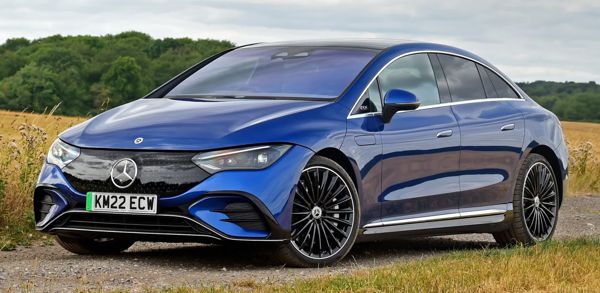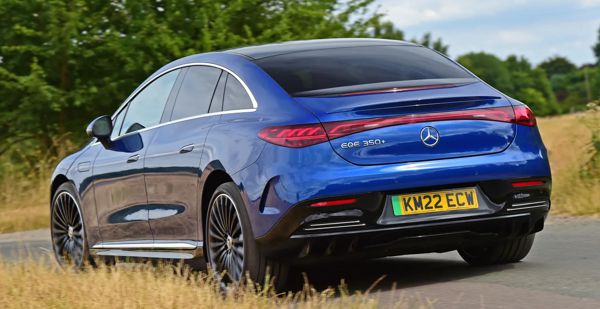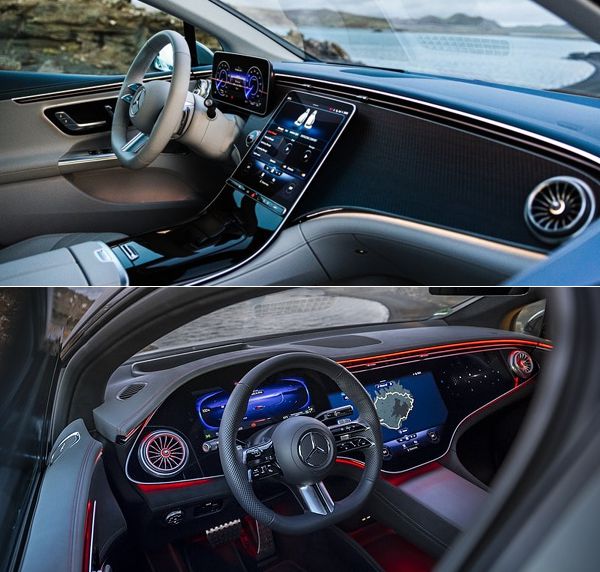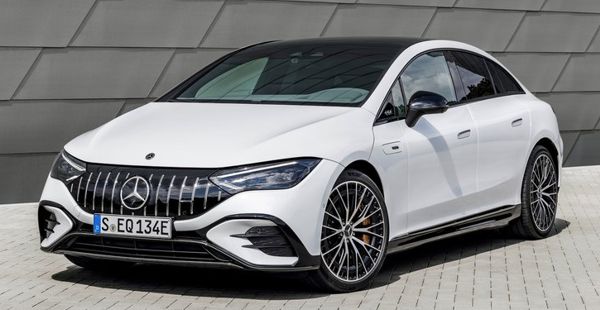Published
on 17
Oct 2022
|
All rights reserved.
|
|
|

|
|
The
EQE and EQS are characterless. And you know, characterless is the worst
thing can happen to a luxury brand.
|
|
If
you know what an EQS is, then we can save 500 words and summarize the
EQE in a single sentence: it is a 90-percent scale EQS. Full
stop.
The EQE and EQS are not only derived from the same skateboard EV
platform called EVA, but they share virtually the same exterior and
interior design. Russian dolls you may call them.
They have the same 400V electrical architecture and 170 kW charging
capability – admittedly not quite enough to match some rivals’ 270 or
350 kW – but the electric motor of EQE produces 10 percent less power
than that of the EQS. However, the smaller car is sold at 70 percent
the price of EQS, yet Mercedes claims both of them will enjoy about the
same profit margin as its existing combustion power models. How can it
manage that?
Part of the cost saving comes from the battery. At 90.6 kWh (net), it
is 85 percent the capacity of the one found in EQS. Then the chassis,
which is predominantly made of steel, with only a few crash beams and
suspension tower brackets made of aluminum, unlike the EQS whose
monocoque is more than 50 percent aluminum. That said, skins like
doors, bonnet, boot lid and front fenders are still made of aluminum.
And then the aerodynamics is not quite as polished as its bigger
sister. Its drag coefficient is 0.22, 10 percent higher than the EQS
and merely matches the S-class and A-class sedan. For an electric car,
especially one shaped like a banana, that’s a bit disappointing.
Speaking of banana shape, the EQE (as well as EQS) is no CLS-beauty. It
looks simply too bulky, blame to its excessive height of 1510 mm and
the high scuttle line (the line where the windscreen and bonnet meet),
both make the car look somewhat like a monospace MPV from the front.
Perhaps Mercedes stresses too much on aerodynamics, or their designers
just fail to hide the bulkiness of skateboard structure as good as
Tesla or Porsche. We have to question their taste, too, as the shiny
black plastic panel fascia at the nose looks cheap, having none of the
expensive perception of the brand’s traditional grille.

|
|
EQE350
lacks both performance and driver engagement, though Mercedes does
comfort and refinement better than others.
|
|
Mercedes
always does very well in styling, successfully evolving its design to
meet modern requirements yet retaining a unique character and sense of
expensiveness. Sadly, having decided to abandon everything that
characterize a traditional Mercedes, they are lost. The EQE and EQS
seem to be shaped by just aerodynamics. They are characterless. And you
know, characterless is the worst thing can happen to a luxury brand.
The EQE might be smaller than EQS, but it is still a large car. At
nearly 5 meters long and 1.94 meters wide, it is larger than the
E-class. Without needing to accommodate engine up front, its wheelbase
can be stretched to an astonishing 3120mm, just 90mm shorter than EQS.
On the downside, the EQE is heavy. Base model already tips the scale at
2280 kg, 625 kg more than an equivalent E-class!
Mercedes claims its cabin is 80mm longer than the E-class. That’s true,
because you will find vast of legroom at the back seat. However, if you
are taller than 6ft 2in, you will find the swoopy roofline presses
against your head. Moreover, the
shallow windows and high waistline confine outward vision. It needs
very much the panoramic glass roof to avoid feeling claustrophobic, no
wonder that option is made standard equipment in some markets.
While glass roof help freeing up the ambience, visibility is not.
Rearward visibility is rubbish, poorer than many supercars in fact,
because the rear screen is small and fast and positioned very high. A
victim of chasing aerodynamics efficiency. Forward vision is not much
better, as the A-pillars are placed so forward that difficult to see
the cars coming out at junction. The bonnet is so steeply raked that
you cannot see the nose of the car, especially there is no longer a
3-pointed star logo standing at the nose, so you absolutely need the
help
of sensors and cameras to slip into tight streets or during parking.
Luggage space is also disappointing for a car so large. It is only 430
liters, 210 liters less than the E-class saloon. There is no luggage
space up front either, unlike Tesla. Moreover, while the EQS has a
liftback, the EQE doesn’t. That’s another area to save cost.

|
|
Church-quiet
interior is compromised by some cheap materials. Hyperscreen is too
expensive.
|
|
Like EQS, the cabin design is big departure from traditional Mercedes.
It is simpler and less elegant than traditional Mercedes cabin but
heavier on technology, dominated by large and bright screens and LED
ambient lighting. The standard setup includes TFT instrument and a
12.8-inch portrait touchscreen at the center console, like what you get
in an S-class. The fancy “Hyperscreen” found on EQS is once again
optional here, but considering its asking price of £8,000, few
buyers will opt for it. Unfortunately, quality perception has taken a
backward step. There are more hard plastics than you would find in an
equivalent E-class, certainly not helped by the simpler and plainer
cabin design that is easier to expose material weaknesses. Maybe a base
E-class is just the same, but you won’t expect that for a Mercedes
costing upward of £74,000. Somehow, when you want to keep profit
margin high, the extra cost of battery has
to be recouped elsewhere.
£74,000 will get you a base EQE350 with the leanest trims.
Compared with other premium EVs, its performance is a bit
underwhelming. A single rear motor offers only 292 horsepower to haul
2.3 tons of car, taking 6 seconds to sprint from rest to 60 mph.
Entry-level EQE300 is slower still – 245 hp and 7 seconds. Switching to
twin-motor setup, EQE500 4matic upgrades to 408 hp and 5.3 seconds.
Further up, it is the AMG territory. If money is no object, of course
you can have your EQE upgraded to supercar performance level, but the
mass selling EQE350 is just not quick enough in the EV world.
Fortunately, Mercedes still does comfort and refinement better than
others. Not only powertrain refinement is first class, the EQE’s cabin
is superbly insulated from all sorts of noises and harshness. Even
riding on the largest 21-inch wheels with AMG Line trim, the air
suspension offers a supple ride on most surfaces except the sharpest
bumps, all the while maintaining a quiet environment E-class owners
will be jealous of. Mercedes’ adaptive regenerative braking mode is
intelligent enough to sense the driving conditions and adjust
regeneration level accordingly, so it feels very natural.
Thanks to the low-mounted battery and the usual Mercedes toys of air
suspension and adaptive dampers, the EQE controls its body motions
tidily, but you will feel its substantial weight when push it harder.
It is not a driver’s car, blame to a numb steering, spongy brake pedal
and lack of adjustable balance that take driver engagement out of the
equation. This means, if you go for driving thrills, you should opt for
Porsche Taycan, BMW i4 or, why not simply the traditional E-class or
5-Series?
At least, the EQE offers class-leading driving range. WLTP figure of
EQE350 is outstanding at 639 km (almost 400 miles), and that will
translate to 500 km in real-world usage. The twin-motor EQE500 manages
590 km (367 miles).
Trouble is, the EQE is way too expensive for what it offers. While the
starting price of £74,000 sounds harsh enough, upgrade to
desirable trims like AMG Line Premium+ will push the price to almost
£90,000, which is S-class territory! A well-equipped diesel
E-class can be had for just over £50,000, and you will get more
luggage space, better cabin materials and more driving fun from the
traditional Mercedes saloon. We want to like the EQE, but sorry, it is
hard to recommend.
|
Verdict:    |
Published on 17
Oct 2022
|
All rights reserved.
|
|
AMG EQE43 and EQE53
|

|
|
The
fact that EQE53 is way more powerful than E63 but still labeled as a
"53" reflects that it is not exactly a driver's car like the E63.
|
|
The AMG versions of EQE is
equally expensive. Even though it is not exactly a top “63” model, AMG
commands £114,000 for EQE53, plus £8,400 if you opt for
"Hyperscreen". Some markets get the less powerful (but shares mostly
the same chassis) EQE43 at 10 percent cheaper, but both sound
unreasonable beside the traditional E63 S at £100,000.
Just like the regular EQE, the EQE53 can be seen as a 90-percent scale
EQS53. It shares the latter’s twin-motor setup with a more powerful
6-phase rear motor. However, its output is deliberately scaled back by
10 percent from the EQS, resulting in 625 horsepower and 701 pound-foot
of torque (EQE43 is less powerful again at 476 hp and 633 lbft). If you
opt for Dynamic+ package (another £4700 thanks), the ECU will
overboost output to 687 hp and 737 lbft for a short period in Race
Start mode, so that you can try to hit 0-60 in 3.2 seconds. The package
also lifts top speed from 137 to 149 mph. Just don’t mention a Cadillac
CTS-V Blackwing tops 200 mph.
Note that the EQE53 is actually more powerful than the full-house E63
S, but the fact that AMG declines to adopt the “63” moniker reflects
that it is not exactly a driver’s car like the E63. Nothing this side
of 2450 kilograms can be.
Driving at 80 or 90 percent effort, the EQE53 feels like any big AMG
saloons should be. Its AMG-specific suspensions, with bespoke wheel
carriers, knuckles and specific tuning of air springs and adaptive
dampers, accompanied with stiffer bushings and anti-roll bars, maintain
good roadholding and body control. Standard 4-wheel steering, which
steers the rear wheels in opposite direction for up to 3.6 degrees at
below 37 mph, not only aids parking but stabilize the car at speed
corners. With more power sending to the rear axle than the front, it
feels nicely balanced at fast sweeper, too. However, push harder in
tighter corners as you would certainly do in the E63, you start feeling
its immense weight. There’s more lean and the chassis is less willing
to turn. Not even air springs are capable to tighten its vertical and
lateral movements. While the AMG-tuned steering is weighty and precise,
it lacks feel to inspire confidence. The combination of huge size and
poor visibility also hurt confidence to drive fast on twistier,
narrower roads.
On the plus side, the huge steel brakes (410mm front and 380mm rear,
brake-by-wire) is powerful and consistent on any road abuse, so there
is little need to pay another £5000 for ceramic brakes. Even on
21-inch wheels and low-profile 265 and 295 rubbers, the car maintains
relatively good ride comfort. The EQE53 feels most at home on faster
roads. Its driving range might be the shorter than lesser models, but
524km (325 miles) is still practical for most journeys. That’s about
400km in real world.
For an AMG model, the biggest disappointment is sound quality. People
used to buy big AMGs instead of BMW M5 or Audi RS6 for its unique V8
sound signature. An electric car has no engine sound, of course, but
some manufacturers, like Porsche, is creative enough to compose a
Sci-Fi-style sound signature which is found interesting enough. AMG
tries to do the same, but the synthesized sound from “AMG Sound
Experience” is not quite as satisfying to ears. It is fake to the point
of annoying, so you'd better to turn it off and enjoy the quiet
environment. Very fast and pretty capable to be hustled though, the AMG
version of EQE fails to inspire driving thrills.
|
Verdict:    |
|